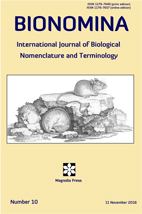Abstract
The nomenclature of the genus Sicista Griffith, 1827 was believed to be reviewed and finally established by Holden & Musser (2005) in the third edition of the Mammal Species of the World. After examining a number of ancient texts we came to several conclusions that should affect the scientific names of several taxa, particularly their synonymy, authorship and dates of publishing. We propose the following names as valid: Sminthidae Brandt, 1855; Sicista Griffith, 1827; Sicista lorigera (Nordmann, 1839); Sicista betulina (Pallas, 1779); and Sicista subtilis vaga (Pallas, 1779). Sicista trizona transylvanica is nomenclaturally available from the publication of the final version of a paper by Cserkész et al. (2016), but not from the early view of that paper which appeared in 2015.
References
Anonymous (1839a) Publications nouvelles. Voyage dans la Russie méridionale et la Crimée. Annales des Sciences naturelles, (2), 12: 229.
Anonymous (1839b) Livres français. 1989: Voyage dans la Russie méridionale. Bibliographie de la France, ou Journal général, 16: 189.
Anonymous [International Commission on Zoological Nomenclature] (2012) International Code of Zoological Nomenclature. 4th edition (online). Ride, W. D. L. et al. (Editorial Committee). <http://www.nhm.ac.uk/hostedsites/ iczn/code/> [Accessed 17 December 2015].
Allen, J. A. (1901) Note on the names of a few South American mammals. Proceedings of the biological Society of Washington, 14: 183–185.
Brandt, J. F. (1855) Beitraege zur nähern Kenntniss der Säugethiere Russlands. Saint-Petersburg (Buchdrukerei der Kaiserlischen Akademie der Wissenschaften): 1–365.
Chaworth-Musters, J. L. (1934) A note on the nomenclature of the species of the ‘subtilis’ group of the genus Sicista. Journal of natural History, 14 (10): 554–556. <http://dx.doi.org/10.1080/00222933408654930>
Cowan, C. F. (1969) Notes on Griffith’s Animal Kingdom of Cuvier (1824–1835). Journal of the Society for the Bibliography of natural History, 5 (2): 137–140. <http://dx.doi.org/10.3366/jsbnh.1969.5.2.137>
Cserkész, T., Rusin, M. & Sramkó, G. (2016) An integrative systematic revision of the European southern birch mice (Rodentia: Sminthidae, Sicista subtilis group). Mammal Review, 46 (2): 114–130. <http://dx.doi.org/10.1111/ mam.12058>
Dubois, A., Bour, R., Ohler, A. (2015) What is an online ‘preliminary version’ of a publication in the meaning of Article 9.9 of the Code?—One more step on the trail of the Asian elephant. Bulletin of Zoological Nomenclature, 72 (1): 6–18.
Dubois, A., Minelli, A. & Zhang, Z.-Q. (2011) Recommendations about nomenclature for papers submitted to Zootaxa. Zootaxa, 2943: 58–62.
Greenough, J. B., Kittredge, G. L., Howard, A. A., D'Ooge, B. L. (1903) Allen and Greenough’s new Latin grammar for schools and colleges. Boston, New York, Chicago & London (Ginn & Co.): 1–642.
Griffith, E. (1827) The animal kingdom arranged in conformity with its organization. Vol. 5. London (William Clowes): 1–391.
Holden, M. E & Musser, G. G. (2005) Sicista. In: D. E Wilson & D. M. Reeder (ed.) Mammal Species of the World. Third edition. Baltimore (Johns Hopkins University Press). <http://vertebrates.si.edu/msw/mswcfapp/msw/ taxon_browser.cfm?msw_id=4118> [Accessed 23 May 2015].
Keyserling, A & Blasius J. H. (1840a) Die Wirbelthiere Europa’s. Braunschweig (Friedrich Vieweg & Sohn): i–xcviii + 1–248.
Keyserling, A. & Blasius, J. H. (1840b) Schreiber der Herren Graf Keyserling und Professor Blasius. Archiv fur Naturgeschihte, 6: 330.
Lebedev, V. S., Bannikova, A. A., Pages, M., Pisano, J., Michaux, J. R. & Shenbrot, G. I. (2013) Molecular phylogeny and systematics of Dipodoidea: a test of morphology-based hypotheses. Zoologica Scripta, 42: 231–249. <http:// dx.doi.org/10.1111/zsc.12002>
Méhely, L. (1913) Die Streifenmäuse (Sicistinae) Europas. Annales historico-naturales Musei nationalis hungarici, 11: 220–256.
Miller, G. S. (1912) Catalogue of the Mammals of Western Europe (Europe exclusive of Russia) in the collection of the British Museum. London (British Museum [Natural History]): i-xv + 1-1019.
Nordmann, A. (1839) Catalogue raisonné des mammifères de la faune pontique. In: A. Demidoff (ed.), Voyage dans la Russie méridionale et la Crimée, par la Hongrie, la Valachie et la Moldavie, Paris (Ernest Bourdin), ‘1840’: 9–72. Ognev, S. I. (1948) Mammals of USSR and adjacent countries. (The mammals of Eastern Europe and Northern Asia).
Volume 6. Moscow & Leningrad (Izdatelstvo Akademii Nauk SSSR): 1–559, maps i–xii. [In Russian]. Pallas, P. S. (1773) Reise durch verschiedene Provinzen des Rußischen Reichs. Theil 2. Saint-Petersburg (Kayserliche Academie der Wißenschaften): 1–744.
Pallas, P. S. (1779) Novae species quadrupedum e glirium ordine. Erlangae (Wolfgang Walther), ‘1778’: i–viii + 1–388, tab. i–xxvii.
Palmer, T. S. (1904) Index generum Mammalium: a list of the genera and families of mammals. North American Fauna. N23. Washington (Government printing office): 1–984. <http://dx.doi.org/10.3996/nafa.23.0001>
Pavlinov, I. Y. & Lissovsky, A. A. (2012) The Mammals of Russia: a taxonomic and geogrpahic reference. Moscow (KMK): 1–604.
Pisano, J., Condamine, F. L., Lebedev V., Bannikova A., Quéré, J.-P., Shenbrot, G. I., Pagès, M. & Michaux, J. R. (2015) Out of Himalaya: the impact of past Asian environmental changes on the evolutionary and biogeographical history of Dipodoidea (Rodentia). Journal of Biogeography, 42: 856–870. <http://dx.doi.org/10.1111/jbi.12476>
Rytschkof, N. (1772) Dnevnyya zapiski puteshestviya Kapitana Nikolaya Rychkova v Kirgis-Kaysatskoy stepe 1771 godu. Saint-Petersburg (Imperatorskaya Akademiya Nauk): 1–104. [In Russian].
Shenbrot, G. I., Sokolov, V. E., Geptner, V. G. & Kovalskaya, Y. M. (1995) Mlekopitayuschiye Rossii i sopredelnyh regionov. Tushkanchikoobraznye. Moscow (Nauka): 1–572. [In Russian].
Sherborn, C. D. (1891) Dates of the parts of P. S. Pallas’s ‘Icones Insect. p. Ross. Sibir.’ and ‘Nov. spec. Quadr. Glirium’. Annals & Magazine of natural History, (6), 7 (38): 236.

